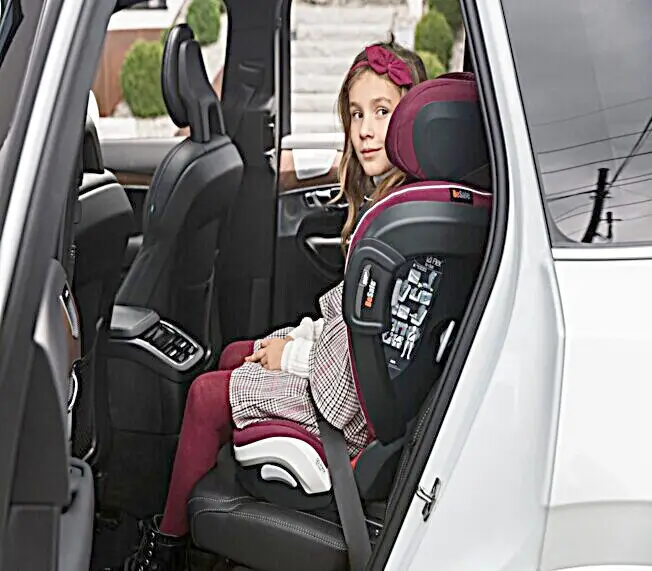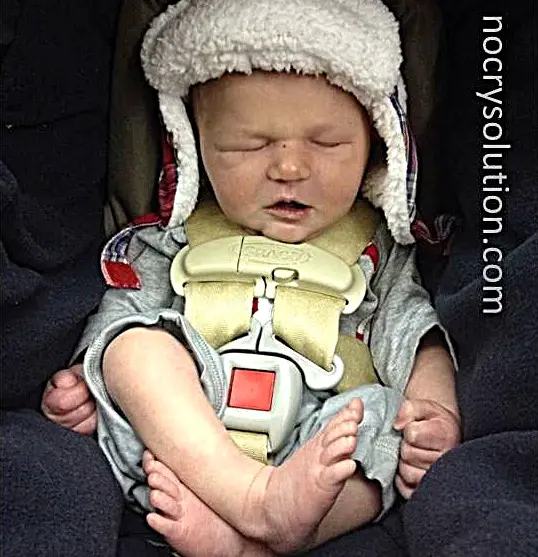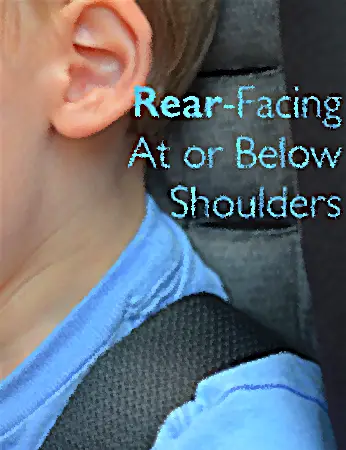
Fitting the Child Correctly in the Car Seat –
- Place your child in the car seat with the child’s back flat against the car seat.
- Place harness straps over the child’s shoulders. Harness straps should lie flat, not twisted, and be placed through the slots located at or below your child’s shoulders.
- Buckle the harness and the chest clip, and tighten until snug. The harness is snug enough when you cannot pinch any extra material at the shoulder.
- Bulky clothing or blankets can prevent a snug harness fit. Always buckle the baby in the seat first, and then place coats or blankets over the harness.
- If your baby needs support, fill the empty spaces with small, rolled blankets on each side of the baby’s shoulders and head.
- If there is a gap between the buckle and your child’s groin (common for young infants), try placing a rolled washcloth or diaper in the space for a more secure fit.
- Never put thick padding under or behind the baby unless it is recommended for use by the car seat manufacturer.
- Place chest clip at armpit level. This holds the harness straps in place on the child’s chest and shoulders.
When can I put my newborn in a car seat?
CHILD CAR SEATS/BOOSTER SEATS –  This is the car seat that your child will use for the longest time – from approx.4 years until 12 years. Using a high back booster seat instead of only a booster cushion ensures that your child is provided with a side impact protection during the whole period of use.
This is the car seat that your child will use for the longest time – from approx.4 years until 12 years. Using a high back booster seat instead of only a booster cushion ensures that your child is provided with a side impact protection during the whole period of use.
Do you have to use the infant insert in car seat?
How to properly buckle a baby in a car seat – Ready to hit the road? Keep these tips in in mind when buckling your child into a car seat:
Dress baby comfortably. Because the harness straps go between a baby’s legs, dress him in pants, leggings or tights that allow you to strap him in comfortably. You should never strap baby into her car seat in a jacket or snowsuit. Because they add an extra layer between your baby and the harness, bulky winter clothing can make it difficult for you to get the harness straps tight enough. Instead, cover baby’s body with a blanket over the top of his secured car seat. Set the seat at a 45-degree angle. If the car seat is too flat, your baby may slide out through the straps; too upright and his head may flop forward too much and make it difficult for him to breathe. That’s why all rear-facing seats have built-in angle adjustors or indicators, so check yours. Your baby’s head should rest at least 2 inches below the top of the car seat. Once your baby’s older and has more head control, he can sit at a more upright angle. Buckle your child in correctly. Gently place your baby’s arms and shoulders through the harness straps, then buckle the crotch buckle and chest clip. Make sure you always fully attach both the crotch buckle and the chest clip. Check your work. Make sure the harness straps are lying flat (they should never be twisted) and are equally snug on both sides. You’ll know they’re tight enough when you can’t pinch any excess fabric along your baby’s shoulder. Next, check the car seat buckle. Is there a gap between the buckle and your baby’s groin? If so, check your manual. Some seats have multiple positions for the crotch buckle, or may allow you to use a rolled up washcloth to fill this space. Finally, check the position of the chest clip. It should sit right at the level of your baby’s armpits. You’ll want to check this last, since it can move around while you’re tightening the straps! Make sure baby’s head is secure. Even at the 45-degree angle, you’ll want to keep an infant’s head from flopping around. Most infant seats come with special cushioned inserts to secure baby’s head; if not, pad the sides and the area around your baby’s head and neck with a tightly-rolled blanket. And never use inserts that don’t come with the car seat; it not only voids the warranty, but it could make baby unsafe. Use rolled-up blankets if baby slouches. Many newborns slouch to one side of the seat. If this happens, place a rolled up hand towel or blanket on each side of your baby’s shoulders. Only use specially-designed supports if they came with your car seat. And never place any padding under your baby, since it can affect the safety of the harness.
Should infant car seat be behind driver or passenger?
Install in the Backseat – The car seat should always be installed in the back seat. That is the safest spot for your baby. If you can, put the car seat in the center seat. If not, it is fine behind either the driver or passenger side. The important thing is that it is in the back, away from the airbags. Even in a minor crash, airbags can seriously injure your little one.
Is it OK to let baby cry in car?
If your baby falls asleep almost before you’re out of the driveway, consider yourself lucky. Many parents struggle with kids who won’t spend five happy minutes in their car seats, which turns “running a quick errand” into a dreaded daily task,  Usually, this crankiness stems from a lack of mobility. Outside of the car, your baby is used to more freedom of movement and more physical attention than you can provide when she’s belted into her seat. Trying to drive while your little one screams bloody murder is challenging to say the least.
Usually, this crankiness stems from a lack of mobility. Outside of the car, your baby is used to more freedom of movement and more physical attention than you can provide when she’s belted into her seat. Trying to drive while your little one screams bloody murder is challenging to say the least.
Even though it’s difficult to deal with, you must remember that you and your baby’s safety come first. No matter how tempting it may be, never take a crying baby out of the car seat. It’s extremely dangerous and counterproductive, making it even more difficult for your child to get used to riding in her car seat.
Making poor driving decisions when your baby is wailing puts everyone in the car at risk. Either pull the car over and calm your baby down, or focus on getting safely from point A to point B—don’t try to do both. The good news is that a few new ideas, a little time and maturity will help your baby become a happy traveler.
Health check, If car seat crying is something new, and your baby has been particularly fussy at home, she may have an ear infection or other illness. A visit to the pediatrician is in order to rule out any possible health risks.
Establish familiarity. Bring the car seat in the house and let your baby sit and play in it, Once she gets used to it in the house, she may be happier to sit there in the car.
Easy entertainment. Keep a special box of soft, safe car toys that you’ll use only in the car, such as furry friends or foam blocks, If these are interesting enough, they may hold her attention during your trip to the store. Avoid hard toys because they could cause injury in a quick stop.
Environment upgrade. Tape or hang toys on the back of the seat that your baby’s facing for her to check out during the drive, Or, string an array of lightweight toys from the ceiling using heavy tape and yarn. Place them just at arm’s reach so that your baby can bat at them from her seat. Don’t use hard toys that could hurt your child if they come loose in a quick stop.
- Poster child.
- Why do the straps need to be set this way? Properly set straps prevent a child from sliding up the seat in a crash, so they are very important.
- They also keep a child in the proper position in the car seat when outside the car, so that the child doesn’t slouch or slip into an unsafe position.
- Note: A newborn baby may require an infant insert, included with the car seat, to reach the lowest slot.
- Your baby could be pulled from your arms and thrown against the dashboard by a quick stop.
- Consider buying, renting, or borrowing a car seat before your baby’s born, when you have time to choose carefully.
- There are two kinds of car seats for babies: infant-only seats (which must be replaced when your baby weighs 22 to 35 pounds, depending on the type of seat) and convertible seats that accommodate both infants and older children.
- Ids who are small can remain in rear-facing seats even after age 2.
- Follow the manufacturer’s guidelines for when to turn the seat.) Never put a rear-facing infant or convertible seat in the front seat of your car — always use the rear seat.
- Passenger-side airbags in the front seat cabin are hazardous for both rear- and forward-facing car seats, and most accidents happen at the front passenger area of the car.
What happens if you don’t support baby’s head?
When this happens, tiny blood vessels can tear and bleed inside the baby’s brain, causing problems such as: blindness deafness fits learning difficulties brain damage, or even death.
How long can a 1 month baby be in a car seat?
Many car seat manufacturers recommend that a baby should not be in a car seat for longer than 2 hours, within a 24 hour time period. This is because when a baby is in a semi-upright position for a prolonged period of time it can result in: 1. A strain on the baby’s still-developing spine.
Where should car seat straps be for newborn?
Use the Correct Harness Slots On rear-facing car seats, the shoulder straps should come through the car seat slots at or just BELOW your child’s shoulders. On forward-facing seats, the shoulder straps should be at or just ABOVE the shoulders.
Where should buckle be on car seat?
Shoulder strap positioning – Rear-Facing Children: Proper Strap Position: The shoulder straps must be emerging from the back of the seat at or just below your child’s shoulders, as seen in this photo. If you can see the slot where the straps are emerging from the car seat, the straps are too high and must be lowered.
Do not use any inserts that were not sold with your car seat. The infant insert sits underneath the baby’s bottom and raises them up so that their shoulders reach the lowest slot.  Forward-Facing Children: Proper Strap Position: The shoulder straps must be emerging from the back of the seat at or just above your child’s shoulders, as seen in this photo. Why do the straps need to be set this way? Properly set straps prevent a forward-facing child from moving forward too much in the car seat.
Forward-Facing Children: Proper Strap Position: The shoulder straps must be emerging from the back of the seat at or just above your child’s shoulders, as seen in this photo. Why do the straps need to be set this way? Properly set straps prevent a forward-facing child from moving forward too much in the car seat. 
Should I ride in the back with my newborn?
The Car Trip – The most important item for the trip home is a proper child safety seat (car seat). Every state requires parents to have one before leaving the hospital because it’s one of the best ways to protect your baby. Even for a short trip, it’s never safe for one of you to hold your baby in your arms while the other drives.
Infant-only seats are designed for rear-facing use only and fit infants better than convertible seats. The American Academy of Pediatrics (AAP) recommends that infants and toddlers ride in a rear-facing seat until they are 2 years old or until they have reached the maximum weight and height limits recommended by the manufacturer.
(If your baby exceeds the weight recommended by the manufacturer before the second birthday, you’ll need to use a convertible seat designed for bigger babies.) Some parents of newborns find that a “travel system” (which includes a stroller and an infant-only car seat that can be attached to the stroller) makes it much smoother to transition babies — especially sleeping ones — from the car to the stroller.
Convertible seats face toward the rear until your baby is at least 2 years old or has reached the maximum weight and height limits recommended by the manufacturer. A child who reaches the height and weight limits before age 2 is safest in a bigger convertible seat and kept rear facing.
When it’s cold, strap your baby in snugly first, then put blankets over the baby. If you borrow a car seat, make sure that it’s not more than 6 years old and was never in a crash (even if it looks OK, it could be structurally unsound). Avoid seats that are missing parts or aren’t labeled with the manufacture date and model number (you’ll have no way to know about recalls).
Also, check the seat for the manufacturer’s recommended “expiration date.” If you have any doubts about the seat’s history, or if it’s cracked or shows signs of wear and tear, don’t use it. Ask at your prenatal classes, health care provider’s office, hospital, or insurance company about rental or loan programs for car seats — they’re quite common.
When buying a new seat, it’s important to remember that there isn’t one type of seat that’s safest or best; get one that fits and can be correctly installed in your car.
Can a 1 week old baby travel by car?
At What Age Can You Travel With A Newborn? – While the specifics vary depending on whether you’re traveling by car, plane, or train, doctors generally agree that it is best to wait till your baby is at least 2 to 3 months old before taking them on a trip.
How long can a 2 week old be in a car seat?
How long can a baby travel in a car seat for? – There is no published evidence which sets out how long babies should be kept in a car seat when travelling. However, infant healthcare professionals, safety experts and most car manufacturers recommend that babies should not be in a car seat for longer than 2 hours at a time and they should be taken out frequently.
Where should the straps be on an infant car seat?
Use the Correct Harness Slots On rear-facing car seats, the shoulder straps should come through the car seat slots at or just BELOW your child’s shoulders. On forward-facing seats, the shoulder straps should be at or just ABOVE the shoulders.
Is it OK to let newborns cry?
Crying it out – If your baby doesn’t appear sick, you’ve tried everything, and he or she is still upset, it’s OK to let your baby cry. If you need to distract yourself for a few minutes, place your baby safely in the crib and make a cup of tea or call a friend.
